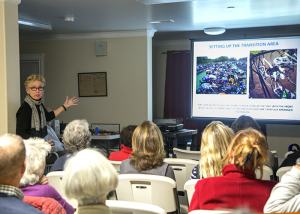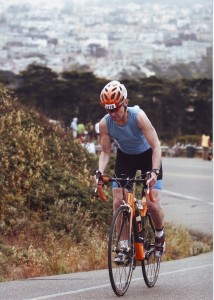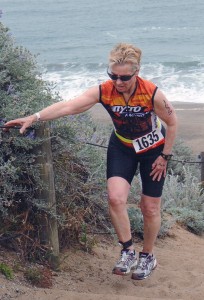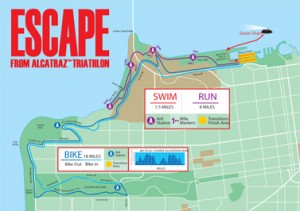Monday, November 24, 2014

Maybe your idea of fun isn’t getting up at 3 a.m. so you can take a one-way boat trip to Alcatraz, jump into San Francisco Bay before dawn, swim a mile and a half, bike 18 miles (with your fingers and toes still numb from the swim), and run eight more miles. That’s the Escape from Alcatraz triathlon, and for Nelda Williams it’s become a life-style. A triathlete since 1983, Nelda has done eight “Escapes,” including her record-breaking effort in 2014, when she eclipsed the previous best time for her age group (65-69) by 29 minutes.
Nelda brought her competitive zest, quick wit, and Texas drawl to SHARP to narrate a slideshow and equipment show-and-tell about her 2014 Escape and her passion for triathloning.
Nelda did her first Escape from Alcatraz triathlon in 2000. She wanted to do something that “scares the hell out of me.” Asked if she experiences constant pain during the race, she said, “Extreme discomfort.” Whatever. She likes it. She says triathloning allows her to achieve her goal of living life with her mind in touch with her body.
Triathlons demand commitment. There’s the monetary cost, to start with. The entry fee for the Escape is $400. Nelda’s bike cost $3,000, just the start of her equipment costs. She trains year round and does 16 weeks of focused training immediately before the Escape. She keeps a detailed training log: “If you don’t measure it, you can’t improve it.”
The race begins with 2,000 people jumping off a boat into the Bay in five minutes—a crowded and chaotic scene. Tip: spread your legs so you don’t go deep into the water. Otherwise, other competitors are likely to land on you while you are surfacing and they are jumping in. It has happened to Nelda. She’s also been socked in the face. “You have to fight for your place,” she says.
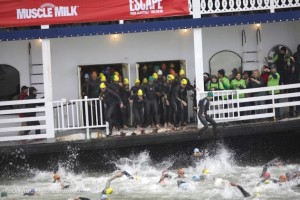
To reach the St. Francis Yacht Club, the end point of the swim, the competitors must negotiate a current that moves out toward the Golden Gate Bridge. To compensate, Nelda swims toward Ghirardelli Square. The water is very salty, and conditions vary greatly. Nelda did the swim in 34 minutes one year, 64 minutes another.
Nelda focuses on efficient transitions from one phase of the race to another. It’s easy to get hung up trying to remove your wet suit as you move from the end point of the swim to the start of the biking.
The 18-mile ride is very hilly with many turns and much potential for a fall. Nelda’s bike speed ranged from five to forty miles per hour. Her triathlon suit was still wet from the swim, and the wind kept her cold. “I’m OK with it,” she says. “I don’t try to be warm.” Motto: ride the bike like you stole it.
The most challenging part of the run is the sand ladder up from Baker Beach. This year Nelda found an efficient way to do it, pulling herself up by grabbing the cable while pushing with her knees. She enjoyed passing younger people on the course, easing up behind them, then “picking them off.” She claims they ran faster after she passed them.
She finished in 3 hours, 51 minutes, compared to 3:13 when she was 55. She seems to be slowing down with age. In that one way, at least, she’s like the rest of us.
Here is the Examiner article that previewed Nelda’s record-setting race. Here is a 2 1/2-minute promotional video about the Escape from Alcatraz race.
Nelda is an entertaining and engaging speaker. She is available to speak to your group and can tailor her presentation to the audience, including kids in an educational setting. If you would like to get in touch with her, you can do so through SHARP’s contact page.
Here’s Nelda’s report on her “Escape” in June 2015 — “I had a slower and far more painful event this year but still came in first in my age group. The second woman in my AG was a full hour behind me, which indicates the difficulty of the course. The water had white caps, and I swallowed so much salt water that I was gagging. Then I got calf cramps and had a very painful low back on the run, so obviously, my training this year fell short in many places. What surprised me most this year was that the course itself just beat me up. I knew I hadn’t done all the required training, but I thought I would just take it easy, not worry about my time, and enjoy the day. I found that wasn’t possible. You have to ante up your dues while training or the Bay and the hills will make you pay. In spite of all that, I’m glad that I did the race; I didn’t crash, have a flat, or have to drop out, so that makes it a good day.”
